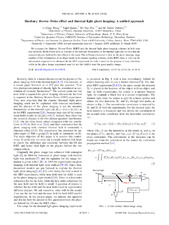| dc.creator | Wang, Li-Gang | |
| dc.creator | Qamar, Sajid | |
| dc.creator | Zhu, Shi-Yao | |
| dc.creator | Zubairy, M. Suhail | |
| dc.date.accessioned | 2011-09-08T21:36:33Z | |
| dc.date.available | 2011-09-08T21:36:33Z | |
| dc.date.issued | 2009 | |
| dc.identifier.citation | Li-Gang Wang, Sajid Qamar, Shi-Yao Zhu and M. Suhail Zubairy. Phys.Rev.A 79 033835 2009. "Copyright (2009) by the American Physical Society." | en |
| dc.identifier.uri | http://dx.doi.org/10.1103/PhysRevA.79.033835 | |
| dc.identifier.uri | https://hdl.handle.net/1969.1/126626 | |
| dc.description | Journals published by the American Physical Society can be found at http://publish.aps.org/ | en |
| dc.description.abstract | We compare the Hanbury Brown-Twiss (HBT) and the thermal light ghost imaging schemes in both near and far fields. Both effects arise as a result of the intensity fluctuations of the thermal light and we find that the essential physics behind the two effects is the same. The difference however is that, in the ghost imaging, large number of bits information of an object needs to be treated together, whereas, in the HBT, there is only one bit information required to be obtained. In the HBT experiment far field is used for the purpose of easy detection, while in the ghost image experiment near (or not far) field is used for good quality image. | en |
| dc.language.iso | en | |
| dc.publisher | American Physical Society | |
| dc.subject | fluctuations | en |
| dc.subject | infrared imaging | en |
| dc.subject | optical correlation | en |
| dc.subject | COHERENT | en |
| dc.subject | RADIATION | en |
| dc.subject | PHOTONS | en |
| dc.subject | BEAMS | en |
| dc.subject | Optics | en |
| dc.subject | Physics | en |
| dc.title | Hanbury Brown-Twiss effect and thermal light ghost imaging: A unified approach | en |
| dc.type | Article | en |
| local.department | Physics and Astronomy | en |


